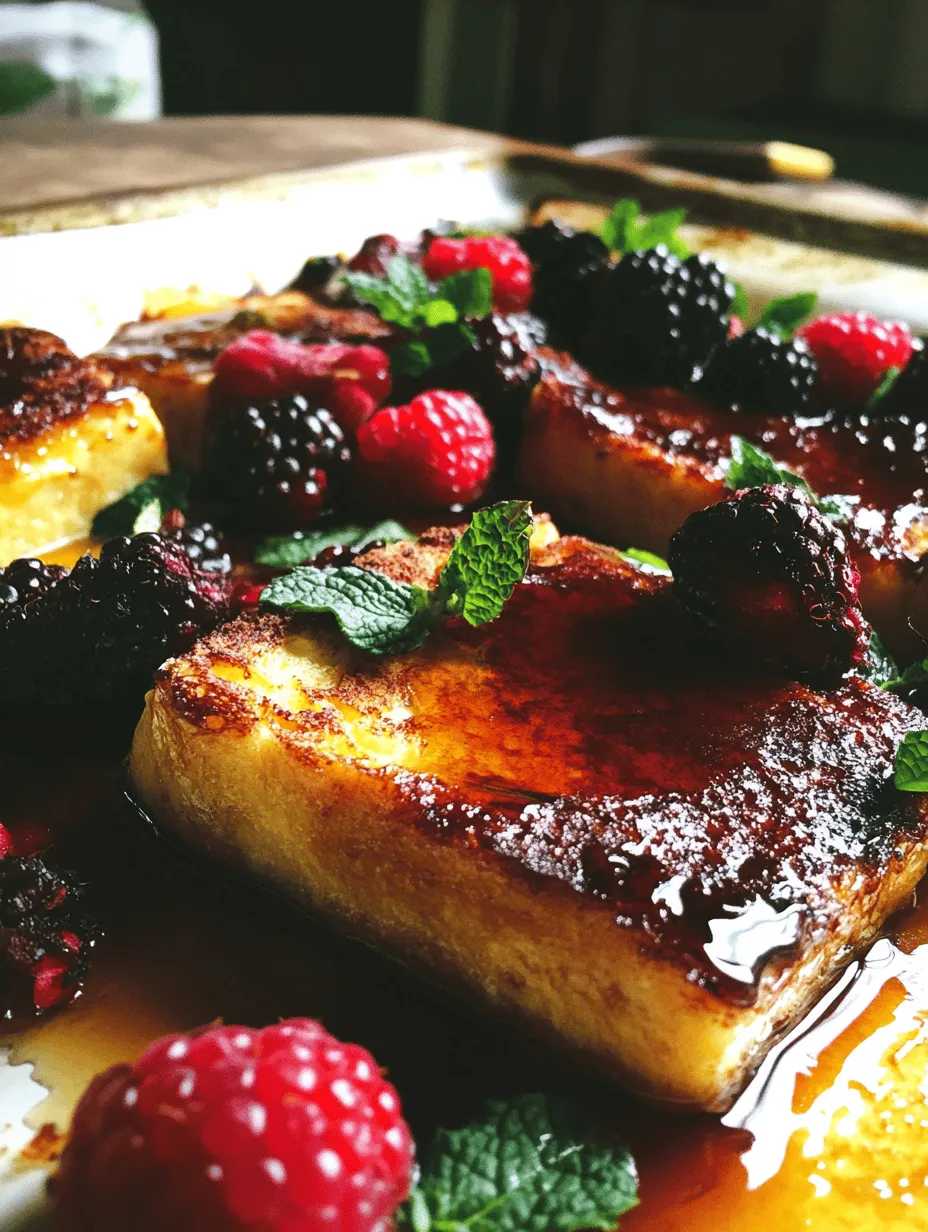Introduction
Imagine waking up to the enticing aroma of caramelized sugar wafting through your kitchen, the scent of sweet vanilla and buttery bread mingling in the air. That’s the magic of Overnight Crème Brûlée French Toast—a recipe that transforms the classic French toast into a sophisticated dish, perfect for brunch or a cozy family breakfast. This delightful fusion combines the creamy, decadent qualities of crème brûlée with the comforting familiarity of French toast, creating a dish that is both indulgent and satisfying.
The allure of this recipe lies not only in its unique flavor profile but also in its effortless preparation. By allowing the bread to soak in the rich custard overnight, you ensure that every bite is infused with sweetness and flavor, resulting in a perfectly moist texture. This overnight preparation not only enhances the taste but also offers a level of convenience that busy mornings often lack. With just a bit of planning the night before, you can serve up a gourmet breakfast that will impress your family and friends without the stress of last-minute cooking.
Whether you’re hosting a holiday gathering, celebrating a special occasion, or simply treating yourself to a sumptuous breakfast, Overnight Crème Brûlée French Toast is guaranteed to be a showstopper. This recipe is not only a feast for the taste buds but also a feast for the eyes, with its golden-brown crust and a satisfying crackle of caramelized sugar on top.
Understanding the Ingredients
To create this delectable dish, it’s essential to understand the roles of each ingredient, as they contribute to the overall flavor and texture of the French toast.
Bread: Challah or Brioche
The foundation of any great French toast is, of course, the bread. For this recipe, you’ll want to use either challah or brioche. Both types of bread are enriched with eggs and butter, giving them a rich flavor and a soft, tender texture. Challah, a traditional Jewish bread, features a slightly sweet and eggy profile, while brioche offers a buttery richness that elevates the dish. The ideal bread should be stale or at least a day old, as this allows for better absorption of the custard mixture without disintegrating.
Eggs, Whole Milk, and Heavy Cream
The custard base of the Overnight Crème Brûlée French Toast is crucial for achieving that signature creamy texture. Eggs create the structure and richness, while whole milk and heavy cream provide the necessary creaminess and depth of flavor. The combination of these ingredients results in a velvety custard that envelops the bread, making each bite indulgently rich.
Granulated Sugar and Brown Sugar
Sweetness is key to any dessert, and in this recipe, both granulated sugar and brown sugar play vital roles. Granulated sugar is used to sweeten the custard base, while brown sugar adds a hint of caramel flavor, especially when it caramelizes under the broiler. The combination of these sugars creates a perfect balance of sweetness that complements the richness of the custard.
Vanilla Extract and Cinnamon
To enhance the flavor profile further, vanilla extract and cinnamon are essential additions. Vanilla extract contributes a warm, aromatic note, while cinnamon adds a comforting spiciness that elevates the entire dish. Together, they create a fragrant custard that brings warmth and complexity to the French toast.
Optional Orange Zest
For those who wish to add a citrus twist, orange zest is an excellent optional ingredient. The bright, zesty notes of orange can cut through the richness of the custard, providing a refreshing contrast. Just a teaspoon or two can make a significant difference, adding a burst of flavor that complements the sweetness of the dish.
Preparation Steps in Detail
Now that we’ve covered the essential ingredients, let’s delve into the important preparation steps that will ensure your Overnight Crème Brûlée French Toast turns out perfectly.
Preparing the Custard Mixture
Start by gathering your ingredients and mixing them in a large bowl. The first step is to whisk together the eggs until they are fully beaten. This process is crucial for achieving a smooth custard mixture. Next, add in the whole milk and heavy cream, followed by the granulated sugar and brown sugar. Whisk everything together until the sugars are dissolved and the mixture is well combined.
Pay attention to the consistency of your custard; it should be smooth and slightly thickened. If you notice any lumps, continue whisking until the mixture is completely homogenous. Proper whisking is essential, as it will prevent any curdling of the eggs during cooking. This step sets the foundation for a creamy and luscious texture.
Layering the Bread
Once the custard mixture is ready, it’s time to prepare the bread. Slice your challah or brioche into thick pieces—about one inch is ideal. This thickness allows for the optimal soaking while still maintaining the structure of the bread.
In a large baking dish—preferably a 9×13 inch size—arrange the bread slices in a single layer. You can create a beautiful pattern by overlapping the slices slightly, ensuring that each piece will be drenched in the custard. The technique of layering is important; it ensures that every slice gets an even soak, which is essential for achieving that rich flavor throughout the dish.
Soaking the Bread
After you have layered the bread, pour the custard mixture evenly over the slices. Make sure to cover each piece thoroughly, allowing the custard to seep in between the slices. A gentle press on the bread with a spatula can help ensure that the custard is absorbed evenly.
This is where the magic of overnight preparation comes into play. Cover the baking dish with plastic wrap or a lid and refrigerate it for at least 4 hours or overnight. This time allows the bread to fully soak up the custard, resulting in a rich and flavorful French toast.
During this soaking period, the bread will expand and absorb the custard, enhancing its texture and flavor. It’s essential to give it enough time, as quick-soaking methods may result in unevenly cooked French toast.
Importance of Refrigeration and Time for Flavors to Meld
Refrigeration is crucial for the soaking process, as it not only allows for the flavors to meld but also ensures food safety. The custard should not be left at room temperature for extended periods, so always refrigerate once the soaking process begins.
Suggestions for Ensuring Even Soaking
To ensure even soaking, you may want to flip the bread slices halfway through the refrigeration period. This simple step guarantees that every piece of bread is saturated with the custard mixture. Alternatively, you can gently shake the baking dish to redistribute the custard if you prefer not to handle the bread too much.
By following these detailed preparation steps, you’ll be well on your way to creating a stunning Overnight Crème Brûlée French Toast that is rich in flavor and texture, ready to impress anyone lucky enough to indulge in it.
In the next section, we’ll discuss the exciting baking process that brings this delightful dish to life.

Preheating the Oven
Before you dive into baking the Overnight Crème Brûlée French Toast, it’s essential to preheat your oven. Setting the right temperature is crucial for achieving that perfect texture—soft and custardy on the inside while having a crisp, caramelized top. Preheat your oven to 350°F (175°C). This temperature is ideal for baking the French toast evenly, allowing it to cook through without drying out.
Importance of the Right Temperature for Baking
Using the correct temperature ensures that your French toast has the right balance of textures. If the oven is too hot, the outside may cook too quickly, leading to a burnt exterior while the inside remains undercooked. Conversely, if the oven is not hot enough, your French toast may end up soggy rather than fluffy. An optimal temperature of 350°F allows for even cooking and caramelization, which is essential for this decadent dish.
Baking Techniques
Once your oven is preheated, it’s time to bake your Overnight Crème Brûlée French Toast. Place the baking dish in the center of the oven to ensure even heat distribution. It’s also advisable to cover the dish with aluminum foil for the first 20 minutes of baking. This technique will trap steam and help the custard set properly, creating a soft interior.
How to Know When the French Toast is Perfectly Baked
To determine if your French toast is perfectly baked, you should rely on both time and visual cues. Typically, baking will take around 40 to 50 minutes, but it’s important to check for doneness around the 30-minute mark.
Visual Cues to Look For During the Baking Process
– Golden Brown Top: The top of your French toast should be a beautiful golden brown, indicating it is developing a crisp crust.
– Firmness: Gently shake the baking dish; the custard should be set but still have a slight jiggle in the middle.
– Edges Pulling Away: As the French toast bakes, you might notice the edges starting to pull away slightly from the sides of the dish, a good sign that it’s ready to come out of the oven.
Creating the Perfect Brûlée Top
After the main baking process, it’s time to create that signature brûlée top that elevates this dish from ordinary to extraordinary.
Switching to Broil Mode
Once your French toast has finished baking, remove it from the oven and let it cool slightly. Switch your oven to broil mode. Broiling is a high-heat cooking method that will create a beautiful caramelized crust on top of your French toast, mimicking the traditional crème brûlée.
Explanation of the Broiling Process
Broiling works by applying direct heat from above, quickly cooking the surface of your dish. This is what gives crème brûlée its characteristic hard sugar shell. When broiling, it’s crucial to keep a close eye on your French toast, as the sugar can burn quickly.
Tips for Achieving the Ideal Caramelized Crust Without Burning
– Use Granulated Sugar: Evenly sprinkle a thin layer of granulated sugar over the top of your French toast. Aim for about 1-2 tablespoons, depending on how sweet you want the crust.
– Keep the Oven Door Ajar: When broiling, keep the oven door slightly open to monitor the process better and prevent overcooking.
– Rotate the Dish: If your broiler has hot spots, rotate the baking dish halfway through to ensure even caramelization.
Serving Suggestions
Your Overnight Crème Brûlée French Toast is now ready to be served, and there are many ways to elevate this dish even further.
Ideal Accompaniments for Crème Brûlée French Toast
Consider pairing your French toast with some freshly whipped cream for added richness. A dollop of crème fraîche can also enhance the creamy texture and provide a slight tang that balances the sweetness.
Enhancing Presentation with Fresh Berries
For a pop of color and freshness, serve your French toast with a mix of fresh berries—such as strawberries, blueberries, or raspberries. These not only add visual appeal but also a burst of tartness that complements the sweetness of the dish.
The Role of Maple Syrup in Balancing Flavors
Don’t forget about the maple syrup! Drizzling high-quality maple syrup over your French toast can enhance its flavor profile and add a wonderful layer of sweetness. The caramelized sugar crust combined with the syrup creates a delightful blend of flavors that your guests will love.
Nutritional Information
While this Overnight Crème Brûlée French Toast is a decadent treat, it is important to be mindful of nutritional intake.
Breakdown of Calories and Nutrients Per Serving
A typical serving (1 slice) of this recipe contains approximately 350 calories. Here’s a quick breakdown:
– Calories: 350
– Fat: 15g
– Carbohydrates: 45g
– Protein: 10g
– Fiber: 2g
– Sugars: 15g
Discussion on Indulgence Versus Moderation
Given its rich ingredients and flavors, it’s best to treat this recipe as an occasional indulgence rather than an everyday meal. Enjoying it during special occasions, holidays, or lazy weekend brunches can make it more special and satisfying.
Recipe Variations and Customizations
One of the great things about Overnight Crème Brûlée French Toast is its versatility. Here are some ideas for variations and customizations to suit different dietary needs and flavor preferences.
Suggestions for Ingredient Swaps
– Gluten-Free Options: Substitute regular bread with gluten-free brioche or a gluten-free bread of your choice for a delicious alternative that caters to gluten sensitivities.
– Dairy Alternatives: For a dairy-free version, opt for almond milk or oat milk instead of whole milk and use coconut cream instead of heavy cream.
Flavor Variations
Feel free to experiment with different flavors:
– Spices: Add a pinch of nutmeg or cardamom to the custard mixture for added warmth.
– Extracts: A splash of almond or vanilla extract can elevate the flavor profile.
– Add-Ins: Consider folding in chocolate chips or diced fruits like bananas or apples for an extra burst of flavor.
Conclusion
Overnight Crème Brûlée French Toast is not just a dish; it’s an experience. The joy of preparing it, the anticipation of the baking process, and the delight in sharing it with friends and family make this recipe truly special. Whether for a cozy brunch or a festive gathering, this decadent treat is sure to impress.
We encourage you to try this recipe for your next special occasion or weekend brunch. Delight in the rich, creamy layers of custard, the sweet crunch of the brûlée topping, and the vibrant colors of fresh berries. Indulging in this luxurious dish will not only satisfy your taste buds but also create lasting memories around the breakfast table. Enjoy every delicious bite!



